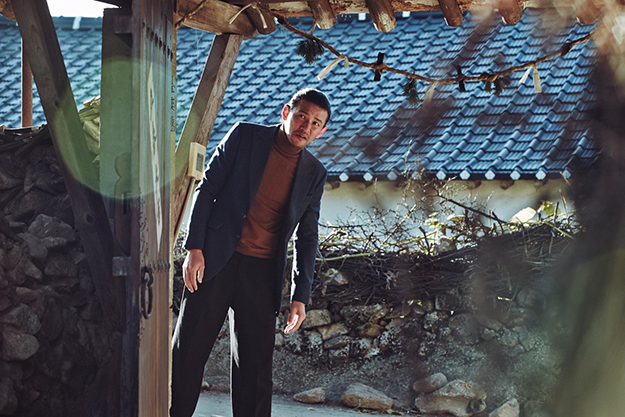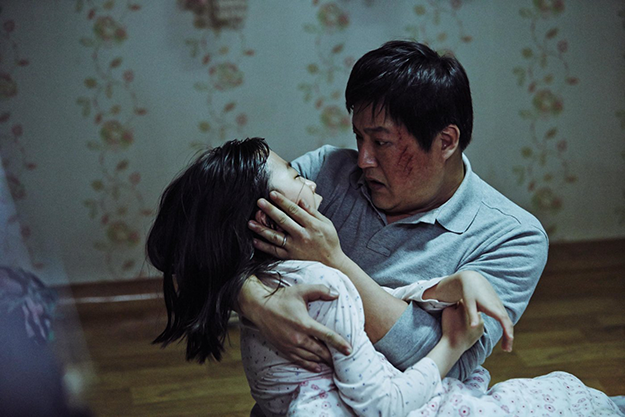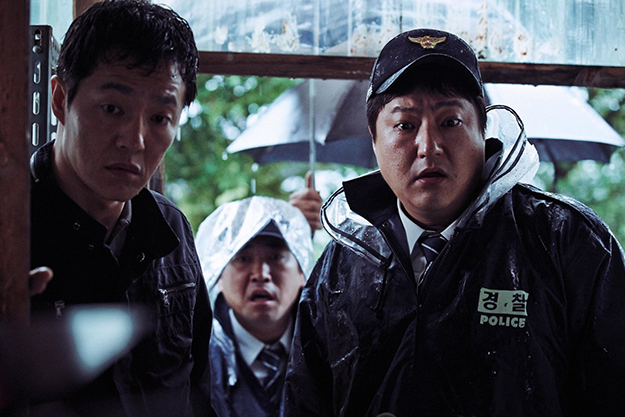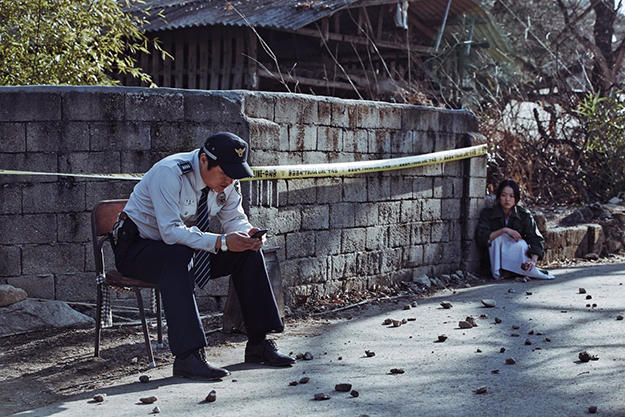Film of the Week: The Wailing
“Can anybody make sense of what’s happening here?” asks the hero of The Wailing—and that’s by no means the only slyly self-referential moment in the film. To really make sense of what’s happening in the latest from South Korea’s Na Hong-jin, you’d probably need to be an expert in the conventions of Korean horror, and writer-director Na may or may not be that. His previous films have been highly successful ventures in a different field of genre cinema—the thrillers The Chaser (08) and The Yellow Sea (10). So when it comes to his first horror outing, Na might as well be reinventing the rules for himself; in which case, he’s doing it very entertainingly, with deranged gusto.
This ferociously full-tilt horror-mystery hybrid carries echoes aplenty from the Western horror canon, with nods to The Exorcist, The Shining (in a mesmeric aerial shot following a car along a twisty, lushly forested mountain road), and Poltergeist—if only because The Wailing echoes that film’s accumulative frenzy, crazily piling up one damned (and I do mean damned) thing after another. But there are also echoes of a great South Korean policier, Bong Joon-ho’s Memories of Murder (03), in the sense we get of an enigma that becomes ever more unfathomable until we’re gazing into an abyss of sheer delirium.
Some reviews of The Wailing, after its recent premiere in Cannes, suggested that the story didn’t make a great deal of sense—and yet imponderability is part of the fun. The story begins with the standard premise of a small-town cop getting into a mystery beyond his capabilities, then starts bifurcating wildly as loose ends and red herrings proliferate. There are zombie-like creatures, cases of demonic possession, ghosts or apparent ghosts haunting the woods, xenophobic paranoia, and possibly a case of poisoning by some kind of baleful fungus—although that’s a thread that never seems to interest Na especially. The whole intrigue, however, is knitted together magnificently by the helpless confusion of the film’s protagonist, Jong-gu (Kwak Do-won), the quintessential bumbling copper but also a devoted, if bemused, family man. The ineptness of the blubbery, boy-like sergeant fuels the film’s distinctly farcical energies—but by the end, you may find yourself shedding tears for him. Without giving too much away, it should be said that while current mainstream horror franchises in the West, of the Insidious vein, like to afford the representatives of order and sanity with at least a temporary glimmer of triumph before the ghouls start twitching again and fixing for a sequel in the final shot, The Wailing relentlessly motors toward a point of nihilistic desperation, with no turning back. At 156 minutes, it’s a long ride but one that barely flags and certainly never loses its nerve.
The setting is a rural small town, Goksung—also the film’s Korean title, which apparently, by a play on the Chinese characters in which it is written, also means “the sound of weeping.” Our man Jong-gu is woken early to investigate a murder, pauses only to join his family for breakfast, then arrives at the crime scene in pouring rain. He finds much discord and screaming there, not to mention two bodies, multiple knife jabs, and a perp in a zombie state, covered in blood and pustules—while, clashing nicely with the gore, the landscape around is a lush, deep green throughout. A key motif of the film is the contrast between the mounting horror and the sumptuous grandeur of the surrounding nature, shot to a degree of beyond-postcard perfection by Hong Kyung-pyo—as in the early image of a mountain range silhouetted against orange variegated skies. The beauty brings little consolation, though, as the natural order proves bleakly indifferent to human sorrows.
More weirdness ensues: a near-naked man seen gobbling a deer corpse runs at the camera with blazing red eyes (cut to Jong-gu exclaiming, “Is that scary or what?”, another cheeky nudge to the viewer). A woman with a blackened face rages at the scene of a house fire; people start having hellish nightmares; a mystery woman in white (Chun Woo-hee) lobs stones at our hero, for no apparent reason other than to make us laugh at his discomfiture. There’s a comic sense of chaos in the air, of anarchy about to erupt at any time—but it’s softened by the almost Abbott and Costello comedy of Jong-gu and his partner, constantly berated as dummies by their boss, and invariably seen backing off in confused terror when faced with anything frightening.
But Na uses the laughs to astute effect. In one scene, Jong-gu and partner go to investigate the house of a man (Jun Kunimura) who is universally suspected of being no good by virtue of being not only a stranger in town but also Japanese; the scene escalates ludicrously as the man’s snarling dog inevitably gets loose of its chain. This episode builds to a note of manic farce, but on the cops’ second visit, Na effectively reruns the same events, only now to horrifying effect, with Jong-gu as much out of control as the mutt. What began as comedy repeats itself as grim hysteria.
As the madness escalates, Jong-gu’s daughter Hyo-jin (Kim Hwan-hee) falls ill, before contracting a bad case of the Linda Blairs—everything but the revolving head, but that’s not necessary, as young actress Kim contrives to convey demonic otherness with such simple effects as a contemptuous glare that’s simply formidable. By this time, The Wailing is just piling on the madness: the family finds a dead goat hanging outside the house, and Jong-gu needs acupuncture treatment for a sudden onset of paralysis. Why? Who knows? Perhaps all this happens purely as build-up, so that his glumly disapproving mother-in-law can mutter to him, “It’s started. You’d better brace yourself.”
Accordingly, enter a very expensive freelance shaman, or possibly showman—a bossy cool cat (Hwang Jung-min) who arrives in a fast car, does a warm-up number with knives and boughs of foliage, then mounts his show-stopping routine, a deluxe “death hex” which he invokes with much keening, slapping of meat, and a team of backing drummers. While this thunderous routine is going on, the Japanese man is carrying out his own quieter ritual, and the counterpointing of the two scenes is the sort of dazzling rhythmic effect that Na and editor Kim Sun-min pull off so dazzlingly throughout.
That’s not the end of it: Na tops this episode with a troubling sequence in which Jong-gu gets up a posse of his buddies (in effect, a vigilante mob) to confront the presumed enemy, piling a pick-up truck with clubs, chainsaws, bones, and rakes. If you like seeing black comic encounters between the vaguely undead and assorted garden implements, then you have a Grand Guignol treat in store. The pursuit ends with a dizzying bit of camera choreography on the edge of a perilous cliff (it doesn’t take much here for brute farce to vault into the realms of poetic vertigo), followed by a bleak coda in yet more rain (Na is a shameless user of baleful weather conditions, but the mountain landscape gives him a certain realistic excuse).
Arguably, there’s way too much misdirection in the final act, and a plethora of inventively grisly spectacle for its own sake—like one character afflicted by a fountainous nosebleed/vomit combo, then driving through a storm of bird shit. At one point, a perplexed Jong-gu asks what transgression of his possibly merited his ordeal, and when he’s told, it doesn’t make sense: it’s as if he was being punished in the first place for something he hadn’t yet done. But as with so many tales of the supernatural, it’s suggested that a primary characteristic of Evil are that it simply likes to put on a show—and that human folly gets what’s coming to it, usually way out of proportion to what is deserved.
A particular dark streak of this film is that being largely sympathetic won’t save a person. Jong-gu is a buffoon and fairly abject as heroes go, and being a loving dad won’t help him; his despairing lapse into lynch mob mentality when he musters his pals is the last straw that dooms him. As Jong-gu, tubby, blinking Kwak Do-won exudes a tender likeability, yet the character’s clowniness is treated as an intrinsic flaw and essentially unforgiveable.
The film’s chaos is offset by often majestic visual grace. The DP is Hong Kyung-pyo, who shot Bong Joon-ho’s Snowpiercer and The Mother, and here he specializes in panoramic wide shots emphasizing the characters’ isolation in a chaotic universe, and highlighting a certain randomness of incident: like the shot where an early morning cyclist brakes, suddenly seeing a figure hanging dead in trees. We constantly get the sense of a village exposed to a vast landscape that feels as if it could swallow it up in a vast maw of cannibalistic greenery. In Hong’s richly textured photography, you feel you can see every single leaf in the forest, but the detail applies to the chaos too: as in a scene where Hyo-jin’s mother and grandmother watch aghast as the girl devours their entire kitchen. The Wailing’s world is a messy mire of excess, but beautifully precise with it.
Jonathan Romney is a contributing editor to FILM COMMENT and writes its Film of the Week column. He is a member of the London Film Critics Circle.











